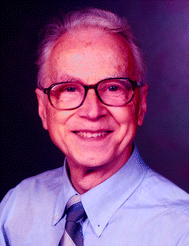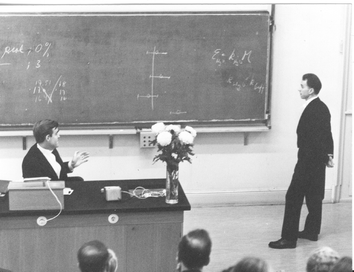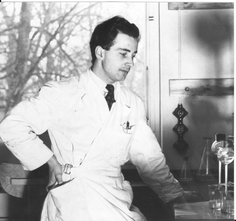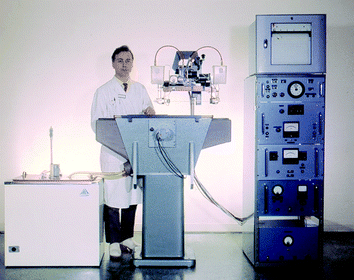Stellan Hjertén, Uppsala University†
Abstract
The Analystprofiles Professor Stellan Hjertén
Professor Stellan Hjertén was born in Forshem, Sweden in 1928. After studying for a BSc in Mathematics, Physics and Chemistry (1954) and an MSc (1958) he received his PhD from Uppsala University under Professor Arne Tiselius (1967) for a thesis on “Free Zone Electrophoresis”. He was subsequently appointed Assistant Professor in Biochemistry at Uppsala University until he was promoted to Professor in 1969. Much of Professor Hjertén’s early research focused on the development of chromatographic beds (agarose and polyacrylamide gels) and capillary electrophoresis and electrophoresis in gels for the separation of biological molecules. These electrophoretic techniques were later to become of fundamental importance for the successful development of modern genetics research, including completion of the Human Genome Project. His group was first to synthesize continuous beds (monoliths) with high resolution and low back pressure. He has received many awards for his research, including: the Electrophoresis Society Founders’ Award (1988); the ACS award for chromatography (1996); and more recently the Golay Award (2002) for pioneering work in capillary electrophoresis. Professor Hjertén is currently Emeritus Professor of Biochemistry at Uppsala University.
Who was the first person to inspire you to follow a career in research science?
In 1954 I was a laboratory teacher at the Institute of Physics, Uppsala University. My intention was to continue my studies in physics on a graduate level, particularly because I was fascinated by the many physical phenomena that can be explained by theoretical—often mathematical—treatment. Although I was never to graduate in physics (one reason being that the atmosphere in the laboratories was not so relaxed and tranquil as I had hoped!), I often use this approach in my research in separation science.
While working on a term project in Biochemistry, I decided to study this discipline further for my graduate studies, following a short discussion in 1954 with Professor Arne Tiselius in his new Institute of Biochemistry. We met in a corridor and without any introductory conversation he asked me whether I was interested in joining his research group. I have never regretted doing so, particularly because he understood my interest in (bio)physics (he himself was a physical chemist and had been awarded the Nobel Prize in 1948 for his research on electrophoresis and chromatography and for his studies of serum proteins). Later I learnt that a faculty colleague of Tiselius, a professor in physics, had recommended me.
What is your earliest recollection of science?
My first research project was centered around separation of proteins by chromatography on calcium phosphate (brushite), detecting them with a UV-sensitive TV camera. During these experiments I found that brushite was not stable at room temperature and slowly transformed to hydroxyapatite. By this observation hydroxyapatite was to become a classical adsorbent, not only for proteins but for nucleic acids as well. The degree of interaction between hydroxyapatite and the sample components is determined by the number of available carboxylic and phosphate groups of the analytes. The separation mechanism is, accordingly, unique. Therefore, a combination of chromatography on hydroxyapatite and on an ion-exchanger often gives a very high degree of purification. The TV camera equipment also became very popular: the staff at the Institute could now follow the Nobel Prize festivities in the City Hall in Stockholm before there were any official TV programmes in Sweden!
Tell us something about your current research projects. Why did you decide to research these areas?
I. Artificial antibodies. A characteristic feature of artificial antibodies is their high selectivity, which can be explained by the molecular imprinting technique by which they are made. At a symposium on molecular imprinting I noted that the lectures dealt only with recognition of low molecular weight compounds, and not of proteins. When I asked about the reason I got the answer that many have tried but without success, most likely because the imprinting must be done in organic solvents and proteins will then become denatured. However, I could not see any hindrance towards making imprints of proteins: rather one could expect a macromolecule, if it is rigid enough, to be adsorbed more selectively and more strongly than small molecules. In fact, the strategy we chose gave satisfactory selectivity following relatively few experiments. Jia-Li Liao, a Chinese PhD student, contributed to the development of the selective gels, as well as the continuous beds (see below).
II. Electrochromatography in homogeneous gels, the true monolithic media. Part of my investigations in separation science have been devoted to the development of new gel media for electrophoresis and chromatography of biopolymers. Any gel which was introduced for chromatography (e.g. crosslinked polyacrylamide) was also quickly used for electrophoresis and vice versa (the agarose gel initially introduced for electrophoresis was somewhat later also employed for chromatography). This early recognized analogy between these two methods later resulted in the derivation of an equation applicable to both chromatography and electrophoresis, as well as centrifugation.‡
No chromatographic packed beds are as homogeneous as the gels used for electrophoresis. Accordingly, the resolution in electrophoresis is much higher than that achieved by chromatography in packed beds. In our efforts to improve the chromatographic resolution, and hopefully come close to that in electrophoresis, we are using derivatives of agarose and polyacrylamide gels as homogeneous stationary phases in electrochromatographic experiments. These gels yield very sharp zones and approach the ideal chromatographic bed material in the sense that eddy diffusion is zero and the mass transfer is faster than that in packed beds, which is reflected in the observation that electrochromatography of DNA gives plate numbers in excess of one million per meter.
III. A hybrid microdevice. The ideal microchip should fulfil the following criteria: (1) It should be cheap to manufacture. (2) It should have low electric conductance. (3) Its thermal conductance should be high when used for electrophoresis to permit high field strengths and thereby short analysis times. (4) It should be UV-transparent. (5) The material the chip is made from should allow coating of the channels to eliminate sample adsorption. As microchips made from plastic or quartz do not have all these properties, we have developed a hybrid microdevice comprising a piece of fused silica tubing serving as separation channel and a supporting plate, preferably made of a ceramic with low electric and high thermal conductivity. Using such a device, a baseline separation of eight standard proteins by molecular-sieve electrophoresis takes 70 s with a supporting plate made from PVC; the analysis time would be even shorter if an appropriate ceramic was used. Although similar resolutions can be obtained by conventional capillary electrophoresis in commercial apparatus, the run time is almost fifteen times longer. Dr Ákos Végvári has made significant contributions to the design of this microdevice.
What is your finest moment?The development of a new separation method often takes several years. Therefore I have seldom experienced that ‘eureka’ feeling. However, there are exceptions: (1) I still remember with pleasure the day I found that blue phycocyanine proteins could be separated by electrophoresis in a polyacrylamide gel into extremely narrow zones, which immediately showed that I had succeeded in my efforts to find a gel which could replace the starch gels for molecular-sieve electrophoresis of proteins. (2) Yao Kunquan was a PhD student in my lab in the eighties. Late one evening he did an experiment on an agarose-based ion-exchanger (synthesized in our lab) which was to have a great impact on the direction of our future research. Upon an increase in flow rate, the bed became compressed and at the same time the resolution of proteins increased. From then on we started a long-lasting project: how to synthesize chromatographic beds with similar properties? We began with different types of agarose beds and then turned to continuous beds—now also called monoliths—and succeeded in synthesizing all these beds with the desired relation between resolution and flow rate. Monoliths are now routinely used in capillary chromatography and electrochromatography. Christer Ericson, a PhD student in my lab, showed that they are superior also to packed beds for experiments in microchips.
At this point I would like to make a distinction between two categories of research problems: those originating from completely new ideas and lines of thought and those that are obvious and, therefore, easy to formulate but yet difficult to solve. Among research projects belonging to the latter category include our successful studies of monoliths and artificial antibodies against proteins. The growing interest in these techniques is an indication that many researchers were stimulated by our new approaches. Before us many researchers had focussed their interest to these research areas and failed.
Which piece of your own work are you most proud of?The main objective of my investigations in separation science is to supply researchers with efficient tools to purify and characterize substances of interest in the life sciences. Therefore, I should be particularly proud of those of ‘my’ methods that have been employed most frequently.
I became particularly pleased when I realized that my early studies of capillary electrophoresis and electrophoresis in gels as well as our later electrophoretic experiments in capillaries filled with polymer solutions, were of fundamental importance for the successful completion of the Human Genome Project (polymer solutions were also introduced by Karger and his coworkers).
Which trends in the separations community are you pleased about? Are there any such trends that concern you?In the late 1950s I used Tiselius’ moving boundary electrophoresis for the analysis of protein fractions from chromatographic experiments on hydroxyapatite. However, it was difficult to collect the 100 mg of a protein required. Therefore I decided to try to develop a micromethod, which resulted in the introduction of capillary free zone electrophoresis. I followed this micro-approach when I developed agarose and polyacrylamide gel electrophoresis in the slab format and monoliths for capillary chromatography, with column diameters down to 0.005 mm. The trend toward miniaturization is very obvious nowadays, but in my opinion it should have come much earlier. The common inclination of many companies to stick to an established product rather than introduce a new one has certainly contributed to the late introduction of miniaturised techniques for analysis. This slow commercialisation of new products hampers the progress of the life sciences as new analysis methods often generate breakthroughs in biology, biochemistry, pharmacy, medicine and many other disciplines.
The analysis methods mentioned belong to techniques which give high resolutions (high plate numbers). However, we also need methods which are designed to give high selectivity, since these lead to still shorter analysis times without the requirement of high efficiency. Among these methods are techniques based on molecular imprinting, which for many years have successfully been used for low molecular-weight substances and now also for biopolymers and bioparticles (see above). This application of molecular and particulate recognition for analyses is very welcome and will probably gain even more in popularity in years to come.
Modern life science research laboratories are equipped with commercially available high-performance miniaturized and computerized instruments and analyses are often performed with ‘kit reagents”. Although this approach has many advantages, it has also an obvious drawback: The direction of the research project may be determined by the data the instruments can deliver, rather than the importance of the project! There is, accordingly, a great risk that new, fundamental urgent areas which require the design and construction of new apparatus and synthesis of new chemicals will not be explored. Compare the different approach Kendrew and Perutz adopted when they determined the 3-D structure of haemoglobin: the primary objective (the elucidation of the structure) was first defined; then the apparatus required was designed, including computers.
Pioneers often experience resistance in getting their new ideas to be widely accepted. How can scientific journals and editors promote novel ideas and bold hypotheses?Interestingly, I have always found that most participants at scientific symposia listen with great interest to a bold new approach to a problem. It is the referees of papers who sometimes have a somewhat negative attitude. In my opinion, the main difference between these two audience types is that the research area of the referee is often very close to that of the author, but more distant from that of most attendees of a symposium. Perhaps the competition between colleagues working in related research areas may explain why it can be more difficult to have a paper based on novel ideas accepted, compared to a more ordinary paper. Another reason may be that the former type of paper often requires a structure which is different from that recommended by the journal. This may be sufficient ammunition for a referee, who may exploit formal instructions to find reasons to reinforce their negativity.
There are most likely many more answers to this question than this, but I do not think there is a ″patent solution″ to the problem. In my experience, a paper will be accepted if the corresponding author can prove that the referee’s statements are incorrect.
A new journal devoted only to novel methods could be the solution. Flexible guidelines and experienced referees would both be needed in order to do justice to these more unusual pieces of research. Personally, I would rather like to see a journal of separation science without any formal house restrictions, but with high quality requirements as to new ideas and thoughts. Many companies should be interested in such a journal and willing to pay an annual fee to get permission to employ novel, patentable ideas. This money, for instance in the form of a research grant, may be used as a compensation to Board Members and referees for the efforts they have to devote to the journal to make it successful. Names of the referees could be published alongside the article to ensure a quality review.
What are your perceptions of the health and vibrancy of research in analytical science today?The access to commercial apparatus for research in analytical science is a ‘must’, but has the disadvantage of fostering conservatism as pointed out above. To mitigate this effect I believe that the students of our universities should be imparted with a better basic knowledge in fundamental chemistry, physics and mathematics at both the undergraduate and graduate level. These students will have a better chance to interpret correctly the data the commercial instruments deliver and to modify the instruments to better fit their own research projects.
Recently you have been working with chip-based techniques. Do you think Lab on a Chip research is a ‘fad’or is here to stay?Generally one can state that any method has its advantages and disadvantages: the chip technique is no exception. No doubt, it has its niche, but I think there is some work still to be done. To be used successfully for quantitative analyses one must find simple methods to eliminate adsorption onto the walls of the channels. This is not a simple problem, especially when the sample is protein-based and the chip is made from plastic, the most widely used material. “Small is beautiful”, but not always: when the sample amounts are sufficiently large more robust conventional methods may be preferred.
For more on Prof. Hjertén’s research see: A Century of Separation Science, ed. H. J. Issaq, Marcel Dekker, 2001, ch. 27, pp. 421–425.Footnotes |
| † Photographs (from top) show (1) Prof. Hjertén, (2) the author at his PhD defence, (3) in front of two columns packed with hydroxyapatite (now a classical adsorbent) and (4) with a fully automated version of his capillary free zone electrophoresis apparatus (1967). |
| ‡ I should emphasize that both Ornstein and Raymond, two American researchers, also introduced polyacrylamide gels for molecular sieve electrophoresis. Smithies is the true pioneer since he was the first to show that gels—starch gels—gave very narrow zones. |
| This journal is © The Royal Society of Chemistry 2003 |




